Stroud News – 2 December 1895 CORRESPONDENCE transcribed by SLHS member Tony Macer, Jan 2015
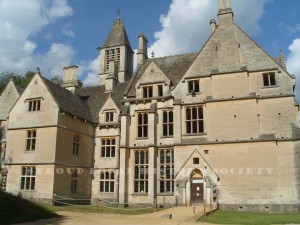
THE LATE MR. BENJAMIN BUCKNALL.
To the EDITOR of the STROUD NEWS.
Sir, – In Mr. Bucknall a notable Stroud-born man passed away a few weeks ago, in his sixty-first year, at Mustapha, Algeria. He has fallen before the mortal foe of us all that
“Stands ready to smite once, and smites no more.”
It has occurred to me that some record of the impressions he has left upon one who knew him for upward of thirty years may not be without interest to your readers of his native town and neighbourhood. In this sketch I have only to concern myself with all that was good in the professional career of my deceased friend – with the uses of natural gifts, mainly developed by self-culture. The light of the life of an architect of distinction is not quenched by death: it abides in the works that embody his conceptions.
APPRENTICESHIP
Of Mr BUCKNALL’s early years I know but little more than that his parents had a business in Stroud, and it was intended that he should become a practical engineer. He had not long made a beginning in this calling, when, by the generous aid of the late Mr LEIGH, of Woodchester Park, – who was the first to discern the bent of his mind for mediaeval art and handicraft – he was articled to Mr Charles HANSOM, the architect of Clifton College, and of the Dominican Monastery of Woodchester. It was either he or his brother who constructed the first cab now known everywhere by the name of the inventor [Hansom cab].
TO PARIS
For some time, as I have heard him say, he took but small interest as a pupil in the office routine of his profession, until one day in Mr LEIGH’s library he came across the numberless drawings in the ten volumes of Viollet-le-Duc’s Dictionnaire Raisonne de l’Architecture Francaise: perhaps the most remarkable work of the century written by one man and illustrated by his own hand. These drawings came to him as revealed truths to awaken his energies, and he at once resolved to learn French in order to be able to study the letterpress. Within a year he acquired sufficient knowledge of the language to make himself understood by our neighbours on the other side of the Channel. Thus equipped, his next object was to go to France, with the view of obtaining, if possible, an introduction to the celebrated author. On arriving in Paris he went to Notre Dame, in that time in the hands of the famous Restorer; and there he was informed by the clerk of the works that his chief would make his round of inspections on the following day. The next morning his one wish above all others was gratified: he met with a courteous reception, and an invitation to breakfast from the master of whom was to become an ardent disciple.
TRANSLATION OF LE DUC’S BOOKS
In the course of the next seven years he translated the five works: – Histoire d’un Maison, Histoire d’une Forteresse, Histoire des Habitations Humaines, Mont Blanc, and Entretiens sur l’Architecture; the latter consisting of twenty lectures prepared for delivery at the Ecole des Beaux Arts – the most important of Viollet-le-Duc books next to the great Dictionnaire. The translations are at present mostly out of print, and not easily obtained. And here it is only right that I should mention that to my esteemed friend, Mr SIBREE, is due the merit to giving to these English versions the scholarly finish that won the praise of the receivers. This has been acknowledged by Mr BUCKNALL in two of his introductory notices. Those were, indeed, happy hours for all three of us spent together at Bussage House and West Grange in weighing the quality of words and phrases so as to render the exact meaning of the original.
WORK IN EUROPE AND CHINA
His first commission was one from the Emperor of the French, gained in competition, to build a small cathedral at Canton. He went over to China by the Cape route to superintend its erection, and remained there until its completion.
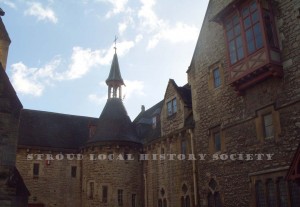
WORK IN GLOUCESTERSHIRE
Soon after his return home he built a church in North Wales, I believe, for Lord DIGBY, and then within no great lapse in time, St. Rose’s Convent at Stroud, the National Schools at Kingstanley, a large house beyond Painswick, and West Grange. Elsewhere, he made considerable additions to the Grammar School in Swansea, including a stately dining hall; also a suburban residence for Mr Charles BATH of that town, beside some smaller dwellings in Wales.
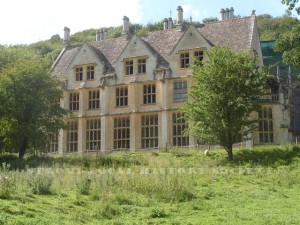
He had, too, much to do with the beautiful domestic chapel and mansion at Woodchester Park; on lines, it is true, laid out by Mr HANSOM; but the details and carved ornamentation were designed by Mr BUCKNALL.
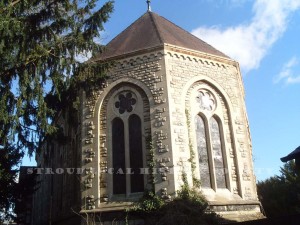
His latest work in this country is the groined and vaulted chapel at the Stroud Convent; graced by him with an interior which for quiet dignity of effect is not surpassed in any modern fabric I have seen in Gloucestershire. In his smaller as in his larger compositions, we recognise sound principals of construction, a true sense of form and proportion, sparse but effective decoration adapted to the materials used and expressive of their purpose – elements which when harmoniously combined as a whole, as they are by him, give as a result unity with variety; sadly lacking, except here and there, in the chaos of the modern building world; brought about by throwing aside tradition and prescription. We live in an age of intellectual expansion, scientific discovery, social amelioration and commercial enterprise; but all who have studied the subject must confess that in the realm of creative art we have not, with all our resources, rivalled the great epochs; when as Mr Taine eloquently expresses it, “the arts were the multitudinous voice of a people singing in unison.” Our originality and pre-eminence are conspicuous in one department only – in landscape painting by Turner and others. There is, however, nowadays, an increasing number of those who feel the importance of cultivating more fully the aesthetic side of our nature – the feeling and perception of the beautiful in man’s handiwork and invention. This has been fostered in late years by not a few designers not gifted with the faculty of combining beauty with utility in the surroundings of our daily lives – chief of whom is the poet Mr W. MORRIS, and among such we may count Mr BUCKNALL – who, in their practice of all that relates to the applied arts, have returned to the “old paths, where is the good way.”
Some of the best stone-masons of Stroud – and there are no better in all the land – have told me that they have never liked their craft so well as when following the lines of Mr BUCKNALL. The masonry and tracery of the Houses of Parliament, as I have stated before in one of my addresses, were chiefly executed by Cotswold masons, who still retain the instincts and methods of their ancestors.
TO ALGERIA
Some seventeen years ago he accepted an invitation to make a long stay in Algeria with the late Mr Charles CAYLEY, who introduced him to his influential circle of friends who wintered there. With the promise of their support, and finding the climate suit his never robust health, he settled down in the Mustapha suburb of Algiers for the rest of his life; usually returning to England for a few weeks about once a year. By the advice of his French leader – “the master light of all seeing” – he kept strictly to the ancient traditions of the country and adjusted them to modern requirements. Judging by photographs that he gave me, and from what I have been told by those who have seen them, not the least of his achievements are in the style of the Moresque or Saracenic, an off-shoot of the Byzantine.
When I happened to meet Mr Smith-Barry some years ago in London, he spoke to me in terms of praise of what he had done for himself and Lady Mary BARRY by converting an old Moorish mansion into their winter residence, adding – “Mr BUCKNALL has the most perfect taste of any man I have ever met”. In fact, all that from him has the sentiment art: form, line and colour were to him as soft clay in the hands of the potter.
In a long, last letter I received from him four months ago he writes:- “I regret exceedingly that you are unable to cross the sea for a visit to my sunny home with its charms of scenery and Oriental life. I should so like you to see the interesting work I have been doing. My buildings attract attention, and have made me many friends among people of distinguished and cultivated taste; among such are Sir Frederick Leighton, Sir Philip Carrie, Lord Carlisle, Lord and Lady Gordon Lennox. The two latter come to Algiers nearly every winter in the Prince of Wales’ yacht, the “Alice.” Among the residents, both English and French, I have also many agreeable and intellectual friends, at whose houses I am always a welcome guest. Among my clients are some Arab chiefs, whose houses I have built or added to – men who have the manner and mien of princes, and with whom I make no contract, for their word is as good as their bond.”
In the summer of 1874 I made a tour with him in France, visiting on one way the cathedrals of Paris, Amiens, Reims, and Sens, the Sainte Chapelle, the Abbey of St. Denis, the Château of Pierrefonds and other historical monuments of France, which owe much of their present state of completeness to the genius of Viollet le Duc, the facile princeps of architectural historians and Restorers. With such a cicerone as my fellow townsman I could hardly fail to derive no small profit in a field which it has been one of the chief pleasures of my life to explore. Three years later we made together a fortnight’s excursion in Switzerland with the late M. Viollet le Duc. Mr SIBREE joined us towards the end of our trip, in time to make a partial ascent of “the Monarch of the Mountains.” These journeys laid the groundwork of two papers I had the privilege of reading at the Royal Institute of British Architects; published afterwards in the “Transactions” of the learned society.
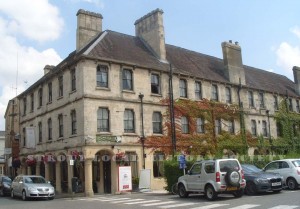 The year before last a brief account of my travels with the lamented Mr HALLEWELL appeared in your columns. I found in Mr BUCKNALL a companion abroad no less congenial. Wherever we went, both had the same aptitude for keeping in touch with everyone in his own range. He whose loss I now deplore had seen much of Eastern cities and old-world places. He had traversed Tunis, strewn with wrecks of ruins of the Roman Empire; he had crossed the Atlas Mountains to the Desert of Sahara; in his wanderings alone among Arabs, Moors, Kabyles had been hospitably received at their houses or in their tents. He was impressed by the primitive simplicity and picturesque aspects of their lives and pursuits of tribes who remain almost unchanged in a world of ceaseless change; recalling to his mind at every turn customs and costumes of antiquity, as we see them reflected in many passages of Holy Writ. Nowhere did he find, to quote his words, “That modern weed of western growth – vulgarity.”
The year before last a brief account of my travels with the lamented Mr HALLEWELL appeared in your columns. I found in Mr BUCKNALL a companion abroad no less congenial. Wherever we went, both had the same aptitude for keeping in touch with everyone in his own range. He whose loss I now deplore had seen much of Eastern cities and old-world places. He had traversed Tunis, strewn with wrecks of ruins of the Roman Empire; he had crossed the Atlas Mountains to the Desert of Sahara; in his wanderings alone among Arabs, Moors, Kabyles had been hospitably received at their houses or in their tents. He was impressed by the primitive simplicity and picturesque aspects of their lives and pursuits of tribes who remain almost unchanged in a world of ceaseless change; recalling to his mind at every turn customs and costumes of antiquity, as we see them reflected in many passages of Holy Writ. Nowhere did he find, to quote his words, “That modern weed of western growth – vulgarity.”
When the question of a new Parish Church for Stroud was first mooted he submitted a design, which if carried out would have been in every way superior to the edifice since erected; but the powers that then were, following the scriptural proverb “that a prophet hath no honour in his own country,” decreed that the commission should be given to a stranger.
Having trespassed to largely on the space at your disposal, I will only farther add that many men of the several races and all ranks in Algiers attended his funeral, to mark their respect for the able architect who was so unexpectedly removed from the sphere of his activity in their midst, where the loss of his light and leading will be long felt
I am, sir, yours faithfully,
CHARLES WETHERED.
Gratnar, near Moreton Hampstead, Devon
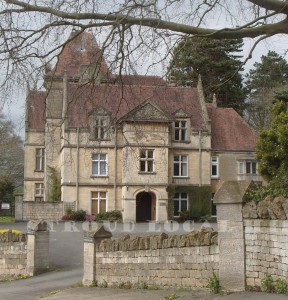
Links to other websites:
More about Benjamin Bucknell on Woodchester Mansion website
Imperial Hotel Stroud designed by Benjamin Bucknall – Digital Stroud website
Benjamin Joseph Bucknall and his brothers Robert and Alfred were all architects link to National Library of Wales pdf
Benjamin’s brother Alfred Bucknell designed Rodborough Court for Sir Alfred Apperly
Added to website March 2016 P Stevens

